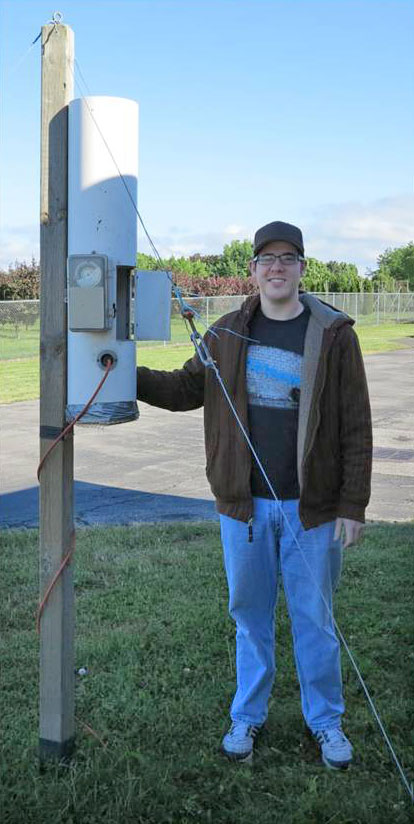For every insect that can damage or destroy a food crop, there can be hundreds of others that look just like it. The ability to tell them apart quickly and accurately can be worth millions of dollars.

Suction trap for aphids
(Photo credit: AAFC)
Dr. Robert Foottit, a research scientist with Agriculture and Agri-Food Canada (AAFC), says fast, accurate identification is critical to effective pest management. "The ability to identify a particular species of insect morphologically—by looking at it, even under a microscope—takes skill and time, often several days or longer.
"If it takes a week or more to find out the insect in your field is a serious pest, it may be too late to save a crop. On the other hand, you may invest thousands of dollars in measures to control an insect that turns out to be harmless."
Genomics offers speed and accuracy
The fastest and surest way to identify a species is through its unique genetic sequence. Building Canada's capacity to deliver that kind of fast, accurate identification is the focus of a major research project funded by the Government of Canada's Genomics Research and Development Initiative (GRDI).
"With the Quarantine and Invasive Species project, the GRDI is enabling a number of federal departments and agencies to work together to build a database of DNA sequences from tens-of-thousands of known organisms," says Dr. Foottit. "With that in place, we need only to extract and sequence DNA from the organism we want to identify—which we can now do in a matter of hours—compare that to what's in the database and see what matches."
Building a valid aphid database

Using conventional methods, separating and identifying different species of aphids collected in trap can be time-consuming.
(Photo credit: AAFC)
Part of Dr. Foottit's involvement in the GRDI project is developing a validated database for aphids. "There are about 1,400 species of aphid in North America alone. Some can cause serious problems and others are more-or-less harmless," says Dr. Foottit. "Many of them look remarkably alike and until you compare them at the molecular level, it is often hard to identify a particular species."
While working on the database, Dr. Foottit discovered another problem. "Sequencing has already been done on a great many of species of aphids over the past decade or so, but genomics has come a long way in a short time," says Dr. Foottit. "As we are going through existing databases, along with missing some species, we are also finding identification errors in some of the sequencing done in the past."
To complete the aphid database, Dr. Foottit is using the best methods available to extract and sequence DNA from his specimens—protocols that have been tested and subject to extensive validation as part of the GRDI Quarantine and Invasive Species project.
Aphids and strawberries
At the AAFC research station in Kentville, Nova Scotia, research scientist Dr. Debra Moreau is already putting Dr. Foottit's research to work for strawberry growers.
"There is a virus complex—a combination of two viruses—that attacks strawberry plants and has been a real problem here in Nova Scotia," says Dr. Moreau. "There is no easy cure—the most effective way to get rid of it is to pull out all the plants and start over."
Dr. Moreau says the best option is finding a way to control the spread of the virus. That's where aphids come in. "The viruses are spread by aphids and many species of aphid can colonize strawberry plants," says Dr. Moreau. "However, only some of those species carry both viruses. If we can identify the species of aphid in a field early enough—we have window of just three or four weeks before they reach the stage where they start flying and spreading to other fields—growers can take steps to get them under control."
Enabling faster, more effective response
Dr. Moreau and her colleagues in Kentville set up traps to collect aphids in strawberry fields. "Using conventional methods, it could take weeks to identify the various species in a trap," says Dr. Moreau. "Using his genomic capacities and database, Dr. Foottit can tell us quickly what species of aphids we have collected, we can check to see if any of those are capable of carrying the virus, and plan a response."
Dr. Foottit's work and the way it is being applied by Dr. Moreau is attracting a lot of attention. "This virus is a concern for the strawberry industry throughout eastern Canada," says Dr. Moreau. "Both Dr. Foottit and I have been contacted by researchers from Ontario, Quebec and the other Atlantic provinces and we are working to set up a network to coordinate future research."